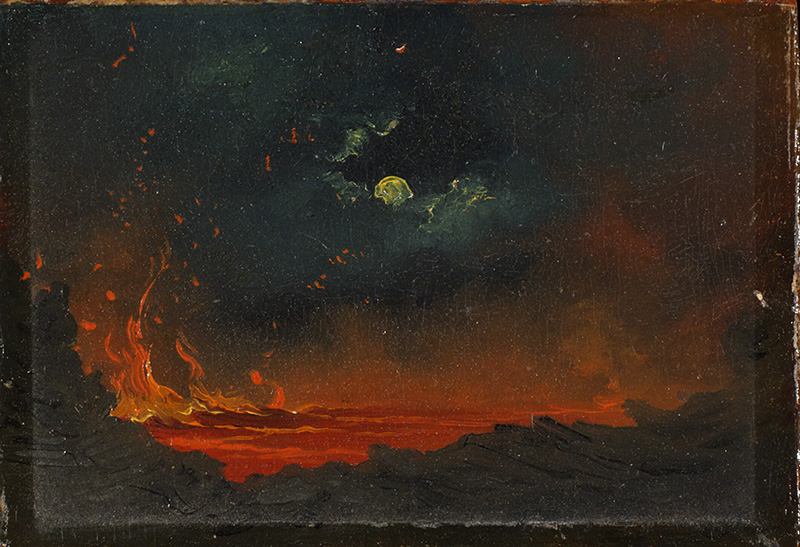𝘒𝘪̄𝘭𝘢𝘶𝘦𝘢 𝘣𝘺 𝘔𝘰𝘰𝘯𝘭𝘪𝘨𝘩𝘵

| Maker | Jules Tavernier |
| Date of Creation | 1885–1889 |
| Location | Kīlauea, Hawaii |
| Materials | Oil on panel |
| Institution | Hood Museum of Art, Dartmouth College |
| Credit Line | Hood Museum of Art, Dartmouth; Bequest of Dr. Frank P. Stetz, in loving memory of David Stewart Hull, Class of 1960 |
| Accession Number | 2009.43.9 |
| Photo Credit | Hood Museum of Art, Dartmouth College |
Jules Tavernier traveled from his home in San Francisco to the Kingdom of Hawai‘i in late 1884. He probably painted this small work from life shortly after his arrival. Thickly applied paint on the craggy rocks and lavas flares entices us to the painting’s finer details. Tavernier transforms the molten lava into a red, atmospheric haze that rises and blends seamlessly into the night’s cloudy atmosphere partially illuminated by the dappled yellow moon. When Tavernier brought small studies like this one back to his studio, he used them as inspiration for painting larger landscapes, which included a 19-foot-long panorama that later toured the United States. These large works and Tavernier’s other Hawaiian landscapes derived from a long tradition of artists traveling great distances to paint distant landscapes and bring their works back to urban centers to exhibit for a curious populace. At the same time, these landscapes helped fuel the nation’s colonizing impulse. In 1893, not even a decade after Tavernier painted this small study, a group of American businessmen primarily from New England backed by the US military launched a coup d’etat against the sovereign Queen Lili‘uokalani. The US illegally annexed the island in 1898. Tavernier’s artwork balances nature’s sublime beauty with real threats of volcanic destruction that lured potential tourists, curious geologists, and astronomers to Hawaii. However, for Native Hawaiians, the lava filling this vast crater is the goddess Pele. For them, this sacred site was, and still is, inappropriate for scientific experiments or tourism. Pele’s magnificence and US colonialism become entangled in this small but intimate work, which ultimately asks us to consider the intersecting, contradicting, and entangled histories from the past, as well as their continued impact in the present.
